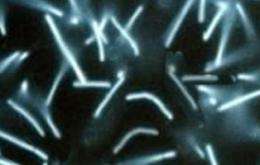In Ocean's Depths, Heat-Loving 'Extremophile' Evolves a Strange Molecular Trick

(PhysOrg.com) -- Making its home near extreme temperatures of thermal vents on the ocean floor, the organism Methanopyrus kandleri harbors a molecular secret that intrigues evolutionary biologists and even HIV researchers.
It turns out that the extremophile M. kandleri contains a mutation that would normally shut down cellular activity, Yale researchers report in the May 1 edition of the journal Science.
The mutation may help the single-cell organism, a member of the Archaea domain, survive in its harsh environment. It may also be an adaptation that combats viruses, which are threats to organisms that live in even the most hostile of environments.
“This exceptional organism provides us with an alternate take on the pathways involved in the production of transfer RNAs. Ultimately this will help us to better understand the diverse processes necessary for protein biosynthesis,” said Dieter Söll, senior author of the paper and Sterling Professor of Molecular Biophysics & Biochemistry as well as Professor of Chemistry
The Yale researchers identified this specific mutation in the genes for 30 different transfer RNAs, which help attach the correct amino acid to protein chains being synthesized inside a cell. At a single location within the transfer RNA molecule of M. kandleri, one of the four nucleotides, a C (cytosine), replaces a U (uracil). This mutation has not been found anywhere else in the transfer RNAs of living cells and, if left uncorrected, could kill the organism.
However, the researchers discovered an enzyme in M. kandleri that converts the mutation back to the standard form and allows the transfer RNA to carry out its work and produce proteins. A crystal structure of the protein, identified by Bradford J. Stanley with his Ph.D. supervisor Yale assistant professor Yong Xiong, reveals how the enzyme might accomplish its essential function.
The newly characterized enzyme functions at the boiling temperature of water. It is a member of the family of so-called cytidine deaminases that mutate DNA and are of great interest to HIV researchers because of their antiviral activity.
“Our enzyme may be of biotechnological interest if we can engineer it to mutate C to U at any desired location within an RNA molecule,” said Lennart Randau, postdoctoral associate in the Söll lab and a lead author of the paper.
Such a potentially damaging mutation must have evolved in M. kandleri for an important reason, said Randau. The scientists speculate that it might be due to the mutation’s role in combating viruses.
Other researchers from Yale involved in the study were Andrew Kohlway and Sarah Mechta.
• Join PhysOrg.com on Facebook!
• Follow PhysOrg.com on Twitter!
Provided by Yale University (news : web)


















